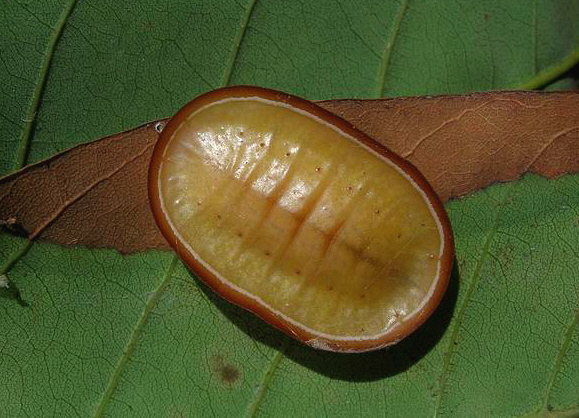
Introduction
The subfamily Liphyrinae comprises of 19 small stout-bodied African species in the genus Aslauga, 3 African species in Euliphyra, and 3 Indo-Australian species in Liphyra. These genera are treated by several workers as members of another subfamily, Miletinae. In the latter arrangement the Liphyrinae are relegated to the rank of a tribe – Liphyrini.
The most well known of the 3 Liphyra species is the “moth butterfly” brassolis, which is distributed from India to the Philippines, and south via Borneo and peninsular Malaysia to Sulawesi, Java and Australia. The other 2 species – grandis and castnia, are both endemic to New Guinea.
The moth butterfly is one of the largest members of the Lycaenidae in the world, with a wingspan of about 70-76mm. The butterflies are heavily built, and have a furry moth-like appearance, hence the common name.
Habitats
This species inhabits rainforest, including degraded and semi-cleared areas, at altitudes between sea level and about 400 metres.
Lifecycle
The extraordinary carnivorous caterpillar of Liphyra brassolis lives inside the nests of weaver ants Oecophylla smaragdina, attacking and devouring hundreds of ant grubs.
The butterfly lays it’s eggs singly on the underside of tree branches. It often returns several times to the same spot, so that several eggs may eventually be laid in close proximity. The chosen tree can be one of several species, but only “ant trees”, are used, i.e. a specimens which have been colonised by weaver ants. Each tree holds numerous ant nests, each constructed by the ants from bunches of leaves which they have stitched together with silk. Each nest may contain between 50-200 worker ants, a queen ant, and hundreds of developing ant grubs.
The eggs hatch after about 3 weeks. The early part of the larval stage is not recorded, so it is not known what the caterpillars feed on during the 1st and 2nd instars, or how they find their way into the ant nests. One possibility is that they feed at first on algae growing on the tree trunks ( as is the case with Lipteninae in Africa ), and are later captured by ants and taken into the nests.
Half grown caterpillars are commonly found within ant nests. A single nest can sometimes house as many as 5 or 6 Liphyra caterpillars. Any insect unfortunate enough to find it’s way into an ant nest would normally be killed and eaten, but the tortoise-like Liphyra caterpillar has a built-in survival kit, in the form of a very tough chitinous carapace that is impervious to ant bites. The ants attempt to flip the caterpillar over to reach the soft under belly, but the caterpillar uses it’s powerful sucker-like feet to pull the carapace down and seal it against the substrate, defeating all attempts by the ants to gain entry.
Whenever the caterpillar is hungry, it lifts the carapace slightly, and pops it’s head out to grab an ant grub with its mandibles. In an instant the grub is pulled under the carapace. The caterpillar then pierces the skin of the grub, and sucks out the juices. The empty skin of the grub is then ejected, and the caterpillar roams a short distance until it locates and kills it’s next victim. Up to a dozen ant grubs can be killed and eaten per hour by a single caterpillar. A few Liphyra caterpillars can easily annihilate an entire brood of ant grubs in a couple of weeks.
The pupa is formed beneath the protective carapace, where it is safe from attack.
In Burma, Thailand and Cambodia the caterpillars and pupae are harvested by villagers for human consumption. They are also used in medicines, and in bird feed and fish bait.
Adult
When the butterfly emerges from it’s pupa, it cracks open the protective carapace, and finds itself inside the ant nest, surrounded by scores of very aggressive ants which try very hard to kill it. They are unable to do so however because the body and wings of the butterfly are covered with loose sticky scales which become detached and clog the jaws of the ants. This enables the butterfly to crawl out of the ant nest and find a safe spot where it can expand and dry it’s wings before taking it’s first flight.
Contrary to popular myth, the moth butterfly is not crepuscular, but flies during daylight like other Lycaenidae. It is unable to feed, as it’s proboscis is wholly atrophied, so it depends for sustenance entirely on fats and proteins stored within its body, acquired during the caterpillar stage.
